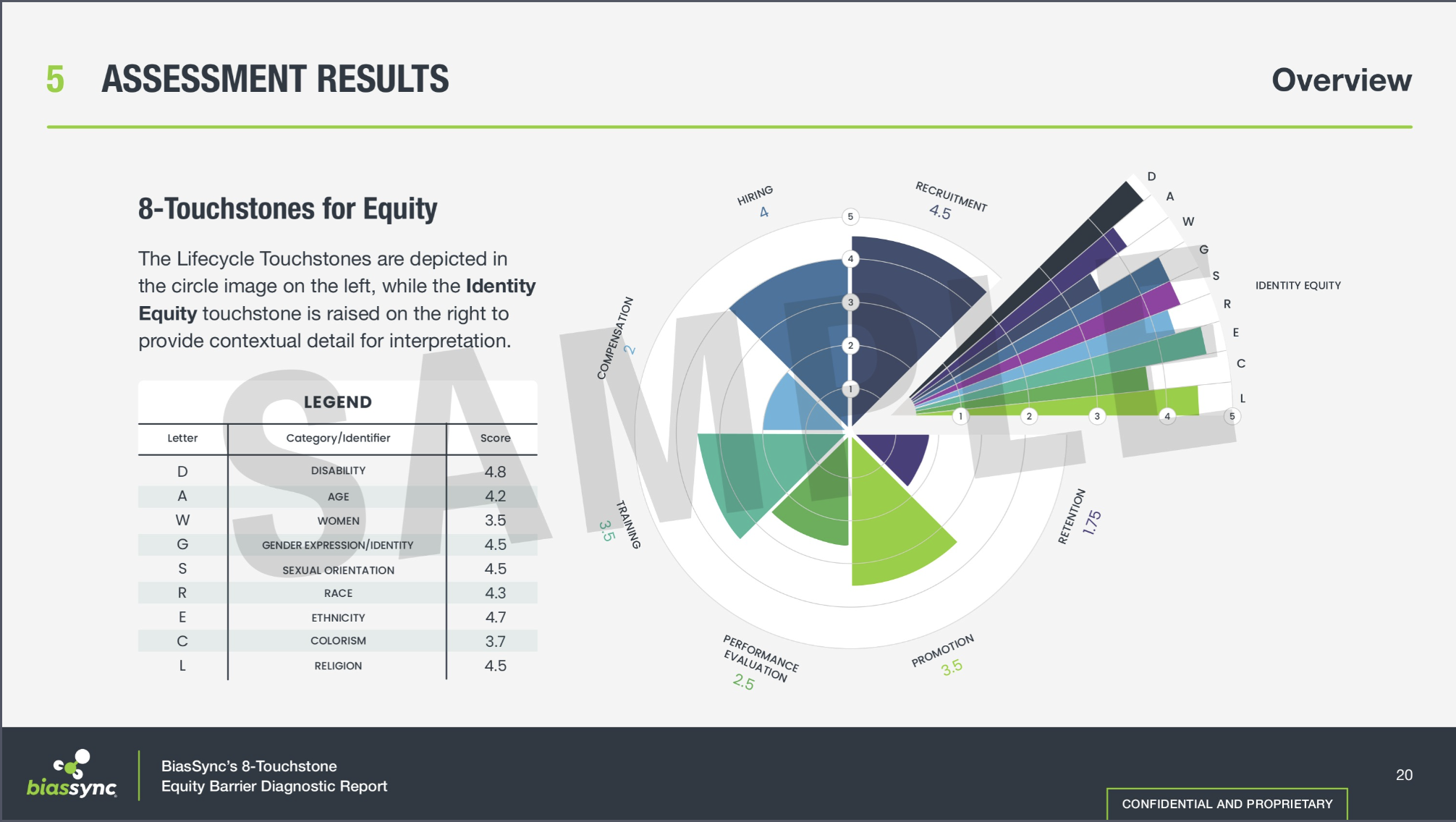
Diagnosing Equity Barriers
BiasSync
ShareWhile the importance of equity in the workplace is widely recognized, it can be difficult to attain. Experts in the field generally highlight the importance of building consensus around an organization’s definition of fairness, as well as developing actionable steps to achieve these outcomes. Yet for many, progress is still hampered by legacy policies and procedures with the unintended consequence of being barriers to organizational equity.
These barriers come in a range of shapes and sizes. More obvious barriers include rampant nepotism or uncurtailed favoritism. But equity barriers can also be extremely nuanced, such as when an organization deploys an incentive program that is aligned with the lifestyle of one employee group over another (for instance, incentives that make it hard for parents of young children).
To achieve equity it is not enough just to support new initiatives. Organizations should also identify and remove existing equity barriers. Research increasingly shows that equity barriers lie within what people scientists commonly refer to as “perception gaps,” or measures where one group may not be able to accurately evaluate the needs and desires of their colleagues. Yet identifying existing equity barriers is a key step on the path to building more fair and productive workplaces. This is especially true because employee experiences of fairness hinge on more than just a checklist of equity practices. To be effective, an organization’s understanding of equity requires a deeper look into the day-to-day lived experience of employees, and the ways in which individual identity and corporate policies and practices intersect.
But how can organizations identify equity barriers? One option is deploying BiasSync’s 8-Touchstone Equity Barrier Diagnostic®, which offers a scientifically-validated and identity-based approach to uncover equity barriers and provide actionable steps forward for all stages of the employee lifecycle.
A Holistic Examination of the Employee Lifecycle
The Equity Barrier Diagnostic® casts a wide net over an employee's journey within an organization.
The proprietary solution probes eight stages, spanning from the initial recruitment phase to employee retention and eventual separation. Unlike many equity audits that focus on isolated aspects of the employee experience, this tool provides a nuanced analysis capable of revealing inequities at each juncture and across demographics. Whereas traditional audits may examine fairness broadly, BiasSync’s 8-Touchstone Equity Barrier Diagnostic® examines compensation, professional development, performance reviews, and promotion from multiple lenses, unpacking identity-based analytics and exploring multiple aspects of fairness in organizational justice. The BiasSync tool examines policies, processes, and outcomes through an equity-focused lens at every point in the employee's lifecycle.
Exploring Inequities through an Identity Intersectionality Framework
Surface-level examination of company-wide equity statistics falls short in providing a holistic understanding of the issues at hand. The BiasSync Equity Barrier Diagnostic® however, employs a sophisticated identity intersectionality framework, categorizing data based on age, color, disability, ethnicity, gender identity, race, religion, and sexual orientation.
This framework, built upon federally protected classes, provides a structure for better understanding how different identity groups experience disparities within the organization. For instance, the tool highlights disparities in promotion rates between disabled and non-disabled individuals, effectively showcasing the gaps that need to be addressed while also providing information on the extent to which intersectionality may play a role in their experience of equity within the organization.
Coined by Kimberlé Crenshaw, J.D., intersectionality is an analytical framework for understanding how aspects of a person’s social and political identities combine to create different modes of discrimination and privilege. Intersectionality identifies multiple factors of advantage and disadvantage due to social constructions of race, class, ability, gender, and other identity characteristics.
There are several features of BiasSync’s approach to organizational equity that set it apart from other approaches. Highlights include:
- Data-Driven Insights for Effective Gap Analysis
BiasSync introduces two powerful tools that elevate organizations beyond anecdotal evidence, offering quantifiable evidence of gaps between advantaged and disadvantaged groups. The Step-by-Step Equity Audit and the 8-Touchstone Equity Barrier Diagnostic® provide numerical insights into disparities, particularly in areas like promotions and compensation. While the equity audit focuses on written artifacts within the organization, such as its policies and procedures, the Equity Barrier Diagnostic® analyzes the lived experience of various employee groups. Armed with this data, organizations are empowered to take meaningful actions that resonate with their diversity, equity, inclusion, and accessibility (DEIA) initiatives. Furthermore, the tool employs best practices to offer actionable recommendations aligned with priorities identified at each stage of the employee lifecycle, effectively fostering a roadmap for evolving equity-focused strategies.
- Scientific Rigor and Identity-Based Analysis
BiasSync's diagnostics and audits transcend mere survey-based approaches, employing a scientific methodology coupled with an identity-based lens. This unique approach unpacks intricate layers of organizational fairness and employee equity. By investigating key factors such as meritocracy, favoritism, procedural justice, and distributive justice, the tool uncovers underlying reasons for perceived barriers. Additionally, the qualitative dimension allows employees to share their personal experiences, which people scientists then analyze, providing a deeper understanding of the challenges at hand.
- Analyzing Equity Barriers Through Identity Intersectionality
Rather than solely examining who receives promotions, the tool delves into the nuanced interplay of different identity dimensions. For instance, data shows that women belonging to multiple disadvantaged groups, such as women of color, often face 6 to 30 times more fairness-related challenges. The Diagnostic delves into the specifics of these challenges, clarifying whether they arise solely due to identity or other factors. By providing inferential statistics on barrier likelihoods and types, BiasSync equips organizations with comprehensive insights into the complex landscape of equity barriers.
 Above: sample of annonymized client data taken from BiasSync's 8-Touchstone Equity Barrier Diagnostic®.
Above: sample of annonymized client data taken from BiasSync's 8-Touchstone Equity Barrier Diagnostic®.
- Unveiling Perception Gaps for Informed Interventions
Perception gaps are a significant obstacle to achieving equity. Certain groups may not fully comprehend the equity challenges faced by others. BiasSync's approach uncovers these gaps, shedding light on areas where more awareness or training is required. By providing perception gap indices, the tool highlights the specific dimensions in which the dominant group fails to perceive identity-related biases. Armed with this information, organizations can target interventions that empower these groups and bridge the perception gap, ultimately fostering a more inclusive environment.
- Insights for Effective Communication
BiasSync's Equity Barrier Diagnostics® Report is a comprehensive analysis that enables quick identification of areas of potential disparities. For Federal agencies, the data and insights can also be integrated into the FEROP and MD-715.
- Continuous Assessment for Sustainable Change
Accountability and continuous improvement are the bedrocks of a successful DEIA strategy. By conducting regular Equity Audits and Equity Barrier Diagnostics®, organizations track their progress against benchmarks and measure the effectiveness of interventions. This approach fosters a culture of accountability and encourages a feedback loop that propels organizations towards a truly diverse, equitable, and inclusive environment.
The Bridge to Meaningful Change
The BiasSync 8-Touchstone Equity Barrier Diagnostic® is a trailblazing solution that ushers organizations into a new era of equity analysis and action. By examining the employee lifecycle through a scientific and identity-based lens, BiasSync reveals disparities, offers data-driven insights, and guides organizations toward meaningful change. With its commitment to ongoing assessment and comprehensive recommendations, BiasSync paves the way for organizations to build diverse, equitable, and inclusive cultures that foster success for all.
For more information on BiasSync’s proprietary equity tools or to view a sample Equity Barrier Diagnostic®, please contact our team.
Not just diversity. Inclusion.
Diversity is not just about numbers. It’s about people’s experiences in the workplace. If you’re ready to understand how bias impacts your company—with data to make effective changes, contact us now.